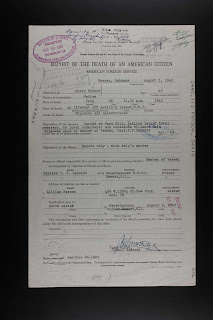If you have ever gone bonefishing in the southern Bahamas and more specifically on Acklins or Ragged Island, I think you will find this interesting. I know this has nothing to do with fishing, but the following put a whole new perspective on Acklins, Inagua and Ragged Islands for me. The 47 survivors of a sub attack that sank their boat spent a month in lifeboat, had a man die from a shark bite, and barely surviving, got a ride on a yacht to Nassau with an heiress. This is a truly amazing story. I urge you to read about it!
My knowledge of the event started with an e-mail I received last night:
Dear Mr. Heywood
I am finishing a book on German submarines in the Bahamas and would like to contact the Ragged Island Lodge regarding a vessel made there for the Rev. William Walter Maycock. It was a 30’ sloop named the GO ON and was critical to the rescue of 47 American sailors from the ship POTLATCH who arrived in nearby Acklins Island after 29 days in an open boat and on rafts, having been sunk in the open Atlantic by U-153 under Wilfried Reichmann on 27 June 1942.
Any e-mail contact on Ragged Island would be much appreciated.
Eric
Eric T. Wiberg, JD
I e-mailed Eric giving him a name of someone who might be able to help him. This was Eric's response.
Good morning Scott,
 Thanks very much for your prompt and very helpful reply - the contact you shared is the only direct line I have with Ragged Island (2 ships, Michael Jebsen and Empire Corporal, were sunk just south of Ragged Island in 1943 by a sub under Holtorf - U-598. I believe - as part of Convoy TAW 12J).
Thanks very much for your prompt and very helpful reply - the contact you shared is the only direct line I have with Ragged Island (2 ships, Michael Jebsen and Empire Corporal, were sunk just south of Ragged Island in 1943 by a sub under Holtorf - U-598. I believe - as part of Convoy TAW 12J).
The POTLATCH survivors landed in the NE corner of Great Inagua, sailed their lifeboat to Little Inagua, then past Hogsty Reef, and made it to a point SW of Acklins Island off Castle Island. Then they waited till sunlight, sailed to a small community which was presumably Salinas, and from there were met with Constable Bain who took them in the GO ON to the Anderson settlement and they walked to Hard Hill. From there the skipper John "Jack" Lapoint walked to buy food supplies and contact Nassau. The 47 men stayed in a school and were looked after by local women. Second Steward David Parson (I attach his bio as well his death certificate in which the skipper lists his relationship as that of "friend"), died in the arms of the skipper within sight of rescue on their final day in the metal lifeboat.
Parson is buried, presumably in the Anderson or Hard Hill cemetery - any chance I could find someone locally through you that would be willing to look for the grave marker?
The Rev. Capt. Collie (not sure first name) officiated the burial. I have been in contact with Mr/Rev Hervis Bain of Acklins but it is very intermittent. I would really appreciate your help as a photo of the grave, which is one of only two providing evidence of all this history, would be huge.
All my best and I recommend you go to www.uboatsbahamas.com and follow the drop-down tabs for ATTACK NARRATIVES and SURVIVOR STATEMENTS for the POTLATCH or any other ships and you will find a lot of detail including original documentation.
Mr. Kendall Butler, author of a book on wooden boatbuilding in the Bahamas, gave me the helpful information on the GO ON. 30' sloop built for the Maycocks in c 1920s, sold to Acklins, he died in 1942, then sold back to his relatives in Ragged.
Thanks again
Eric
The survivor accounts are fascinating go here
The documents above can be seen in more detail.
I especially urge you to read the account by U. S. Navy Sailor Estil Ruggles on page 33. This is simply amazing and I can't imagine their journey. Simply incredible!
 Thanks very much for your prompt and very helpful reply - the contact you shared is the only direct line I have with Ragged Island (2 ships, Michael Jebsen and Empire Corporal, were sunk just south of Ragged Island in 1943 by a sub under Holtorf - U-598. I believe - as part of Convoy TAW 12J).
Thanks very much for your prompt and very helpful reply - the contact you shared is the only direct line I have with Ragged Island (2 ships, Michael Jebsen and Empire Corporal, were sunk just south of Ragged Island in 1943 by a sub under Holtorf - U-598. I believe - as part of Convoy TAW 12J).